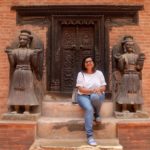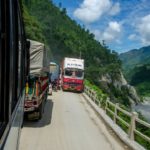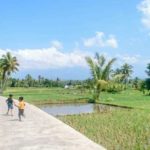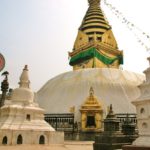Living the Nepali Village Life at the Manikhel Homestay

I take a sip of the raksi, or Nepali rice liquor, and feel the women staring at me. I swallow the strong drink and smile. “Mitho,” I say, which means delicious in Nepali, and their faces burst with smiles of true joy. We are in the small kitchen of a traditional home, sitting directly on the ground. It serves as living room as well as a dining room. The place has no window so the light is dim. In this small space, women gathered to look at me curiously, but also to have a drink together and chat. They get the chance to gossip while taking a break from their daily activities. I had just arrived at this homestay, in the village of Manikhel in the lush hills of the Himalayan foothills, to experience Nepali village life.
It is only 40 kilometres from Kathmandu but a five-hour bus ride and some years apart from the busy, dusty capital city.
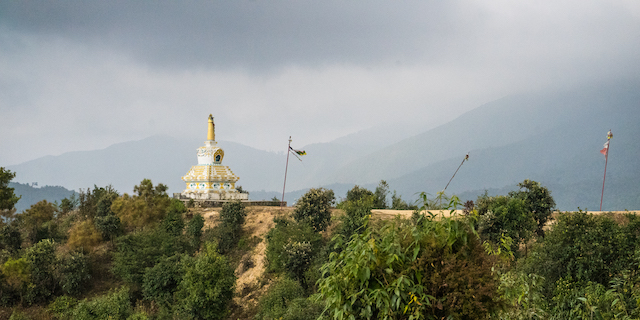
- Photo: Cristina Podocea
In Manikhel, as in many villages in the Himalaya, it seems like time has stood still. While there are signs of globalization, there is still also so many signs of the original culture, traditions and way of living. As part of Duara Travels’ project of promoting responsible tourism by offering authentic experiences in villages all over the world, I came to this village homestay in Nepal. I am quite familiar with Nepal and have travelled here several times, but I am always on the look-out for remote places where I can observe the local life and better understand the various cultures of Nepal.
I feel like I am on a family retreat: delicious food, relaxed walks in nature, time to meditate, community activities.
I have for a long time wanted to get closer to the Tamang community, a Nepali ethnic group originating from Tibet. Manikhel is a Tamang village and the family I stayed with is Tamang. Drinking raksi with them quickly made me one of the family (although I’m sure I would have been treated as one of the family no matter what!).
The community feeling is very strong here; I can see it from the way the women interact with each other. There is familiarity and ease in their gestures and discussions. There is also an obvious respect for the elders: they are served first, they are bolder in their looks and gestures, and they drink raksi with the ease of the trained. The younger women run around after the kids, laugh and drink timidly, and make faces at the strength of the drink.
Nepal is not just Kathmandu, with its fancy restaurants and cafes, and it is not just trekking and nice resorts, yoga retreats and meditation centers. Nepal is this warm, simple, rustic life that happens in the villages lost between the lush hills. This is Nepali village life.
While we were eating our first meal here (curry and rice), I take advantage of the presence of Indra, the niece of my host, who is the local coordinator of the program. I ask her questions about the family, the village and their habits. Tamangs have settled mostly in the fertile areas of east and north-east of Kathmandu. They are mostly Buddhist, but some are Christian too, like the son of Ani (auntie), my host. Among each other they speak their own language, which is entirely different from Nepali.
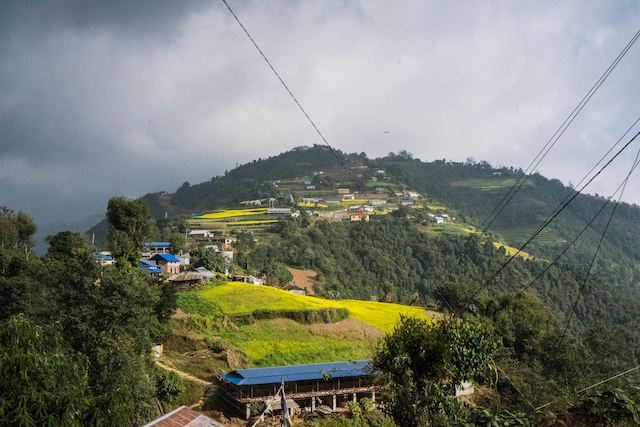
- Photo: Cristina Podocea
The homestay project started around a year ago. The house where I am hosted is modest and simple. It is on a hill, a little above the house of Ani. The toilet is outside, and inside there are basic facilities: a bed, a table, a mirror. Light is provided by solar panels, but there is no electricity socket here, although there is one in Ani’s house. She also has a TV, on which we watch Indian soap operas one night, joined by the extended family and neighbors. The scarcity of resources enhances the community spirit. Here, people help each other because they also need each other.
As the air is cooling and the light dimming, you can sense the joy of coming home and reuniting around the evening meal. Everyone is happy that another day of work has ended, and they are ready to celebrate it.
This becomes obvious when, the next day, I go for a walk with Indra and Ani. The village is actually spread over two hills. Indra’s house is on the opposite hill. We slowly go up, in no rush. We pass the small, colorful monastery. Indra and Ani stopped everywhere to greet people and exchange news. Everyone was smiling and willing to chat. They looked at me curiously, and obviously asked Indra and Ani what the deal is with me.
As soon as they hear the story and I greet them, they offer me big smiles and greetings. We stop at “this friend of mine” and gather some salad to accompany the curry. There is another friend from whom we get corn for breakfast. Everyone is a friend or family here. They all provide us with what we need to prepare the food, while chatting happily.
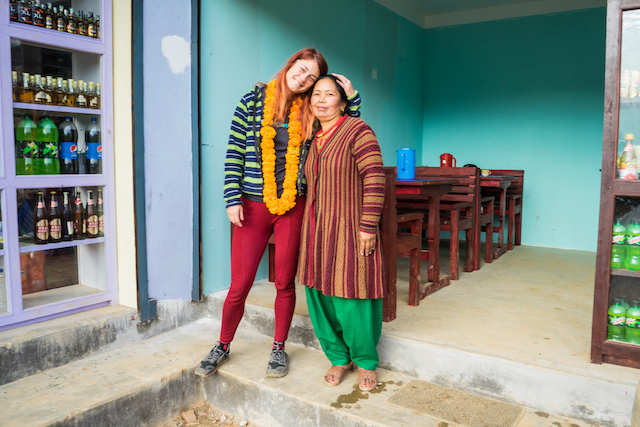
- Photo: Cristina Podocea
Oh, and the food! It is the most delicious I have had in Nepal! The ingredients are fresh from the garden and cooked the same day. My favorite daal bhat meal was one made with fresh fish from the farm nearby. About one hour’s walk from the village, there is this farm with several ponds and fish of different sizes.
While hiking there in the morning I had the opportunity to chat further with Indra. After finishing her studies in Kathmandu she wants to come back to the village and work on her father’s farm. She loves plants and the warmth of village life. I can definitely see why. I feel like I am on a family retreat: delicious food, relaxed walks in nature, time to meditate, community activities.
While we dance, sing and laugh, and I don’t feel any difference between me and these people. We are the same, we are like a family.
In the three days I spent there I took time to observe village life: in the morning, people gather at the local shop for tea and breakfast. They seem in a hurry to start the day’s activities, but they still take time to enjoy their sweet tea and roti. Before noon you can see people going about their activities, mainly working on the land or around the house.
Children in uniforms hurry to the village school. The bus is honking its imminent departure to Kathmandu. By noon, the shop is invaded by children on their lunch break. They eat their curries quickly while looking at me with big, curious eyes.
The real spectacle comes as the evening approaches. The families are gathering. Small groups of people here and there drink tea and chat. Men and women come back from the fields. Children play freely on the streets. Cattle is brought home. As the air is cooling and the light dimming, you can sense the joy of coming home and reuniting around the evening meal. Everyone is happy that another day of work has ended, and they are ready to celebrate it.
With a bit of raksi and some Nepali songs, I stand up in the small kitchen and start dancing. Ani joins me happily. She is showing me dance moves while smiling broadly and encouraging me to let loose. We try to imitate the dancers from the music video. While we dance, sing and laugh, and I don’t feel any difference between me and these people. We are the same, we are like a family. I feel I belong here.
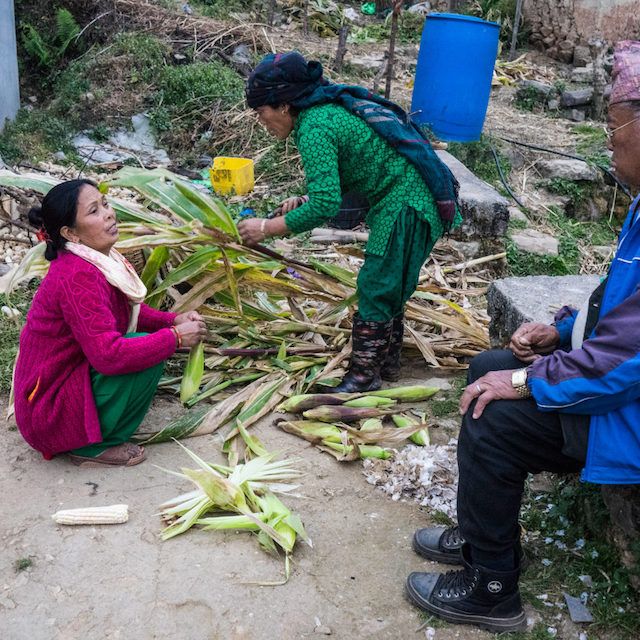
- Photo: Cristina Podocea
This experience was like a retreat.
The next day I must leave. The bus will take me away from this tranquil, warm place and back into the frenzy of Kathmandu. This experience was like a retreat. It’s just what you need if you want to get a feel for how life really is in Nepal. Because Nepal is not just Kathmandu, with its fancy restaurants and cafes, and it is not just trekking and nice resorts, yoga retreats and meditation centers.
Nepal is this warm, simple, rustic life that happens in the villages lost between the lush hills. Where time takes different dimensions and from where Nepalis take their tranquility and energy. Nepal is community. If you want to experience that, then you should try a community homestay, like the one offered by Duara.
The author received a complimentary stay at Duara Travels’ Manikhel Village Homestay. All opinions expressed are her own.

